We are now living in the real world thanks to the Building a Chatbots. Chatbots have changed how we interact with technology and businesses, even though the idea of talking to robots may have once seemed like a far-fetched idea. The Building a Chatbots has been crucial to this amazing journey, especially in the area of Building a Chatbot Using NLP.
In this blog, we will explore How To Build A Chatbot Using Natural Language Processing in 2024 has been at the forefront of Building chatbots. By improving customer service, streamlining procedures, and enhancing user experiences, chatbots have completely transformed business. They provide round-the-clock service, handle routine inquiries, and provide real-time assistance, making them essential tools for companies looking to maximize productivity and satisfy customers.
Table of Contents
Whether you’re a technology enthusiast, a business owner, or an educator, understanding the evolution of chatbots, especially in the context of Building a Chatbot Using NLP, is key to appreciating the remarkable progress that has led us to where we are today.
Chatbot Market Overview
According to Statista, the chatbot market will increase at a compound annual growth rate (CAGR) of 29.6% between 2022 and 2027.
Chatbot usage is especially visible in a variety of industries, with significant increase percentages reported in:
- 40% retail
- Financial and banking services (30%)
- Healthcare (25% of total)
- Tourism and travel (20%)
- Communications (15%)
These figures indicate chatbots’ adaptability in meeting the demands of many industries. As chatbots grow, many now understand and respond to natural language, making them more beneficial to both businesses and consumers.
Additional Insights From Leading Sources:
- Gartner predicts that by 2022, 70% of customer interactions will incorporate emerging technologies like chatbots or virtual assistants.
- Research from Drift reveals that companies developing chatbots experience a remarkable 60% increase in website conversion rates.
- Forrester reports that developing chatbots can save businesses up to $30 per customer interaction, highlighting their potential for cost-efficiency.
Why Chatbot is Important?
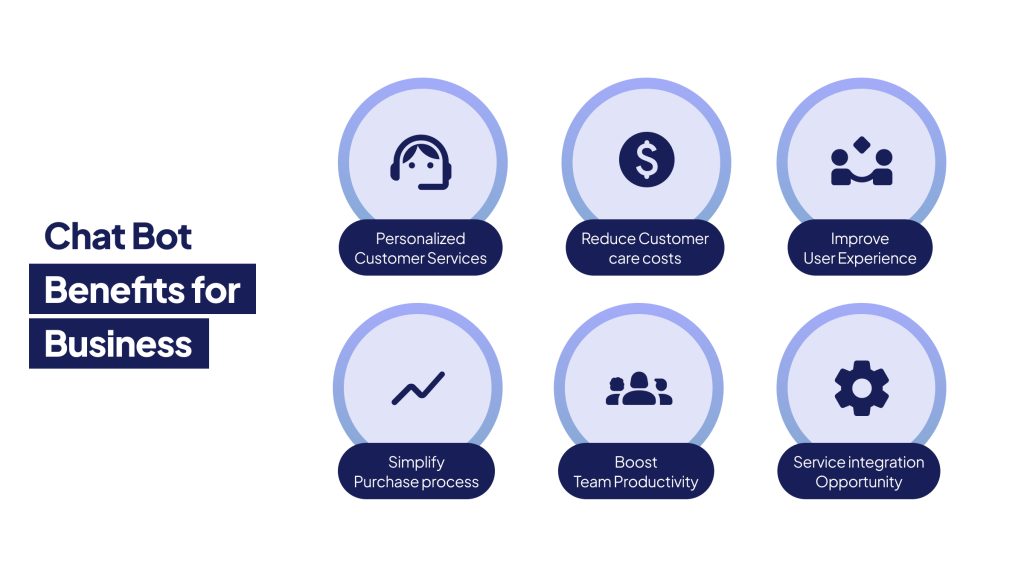
Making Your Brand Interactive And Accessible All the Time
Chatbots allow your brand to be always available 24/7 to customers, giving rapid replies, engaging users, and encouraging brand loyalty by offering a seamless experience.
Customer Data Mining
Chatbots excel at gathering and analyzing important customer data, such as user interactions, preferences, and habits. This data helps firms to obtain insights and successfully modify services to suit client expectations.
Direct Sales in Private Chats
Chatbots can act as your personal shopping assistant, helping you find the right products, offering exclusive deals, and even allowing you to make purchases right in the chat. It’s like having a 24/7 shopping buddy in your pocket.
Savings for Your Support Team
Chatbots take care of common questions and issues, which means your support team can focus on the more complex, tricky stuff. This not only saves your company money but also ensures that your human support team can give the best help where it’s needed most.
Connect with the World in Any Language
No matter where your customers are from, chatbots can chat with them in their preferred language. This opens the door to a global customer base and makes sure everyone feels at home.
Rescue Those Abandoned Carts
Ever left items in your online cart and then changed your mind? Chatbots can swoop in, offer a hand, and maybe a special deal to persuade you to complete your purchase. It’s all about making sure you don’t miss out on those must-have items.
Types of Chatbots
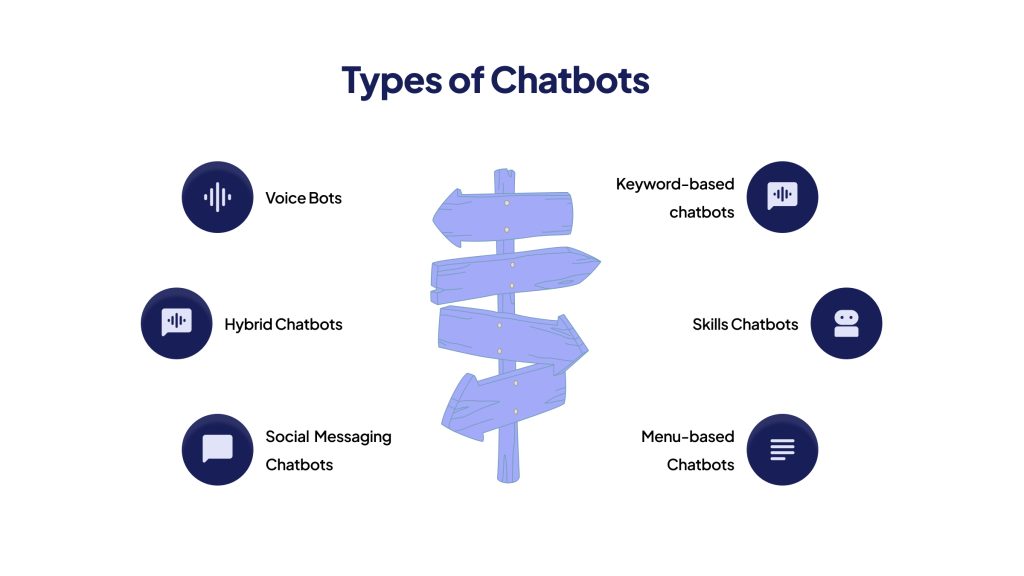
Chatbots Come In Two Primary Categories:
| Rule-Based Chatbots | Chatbots Powered by AI |
| These chatbots operate according to specified rules and can reply to particular instructions or phrases. They are perfect for answering simple questions or carrying out simple activities. | AI-powered chatbots interpret and respond to natural language inputs by leveraging artificial intelligence, namely Natural Language Processing (NLP) and Machine Learning (ML). They are skilled at managing complicated, context-aware talks. |
What Is The Purpose Of AI Chatbot
AI is driving the advancement of chatbots, allowing them to understand the intricacies of human language, discern user intents, and give intelligent, context-aware replies. Chatbots powered by AI are constantly improving their capacity to engage successfully by learning from each conversation.
Out-of-the-box vs. Custom Solutions
The decision between out-of-the-box and bespoke chatbot solutions is based on your company’s particular demands and goals:
| Out-of-the-box thinking | Personalized solutions: |
| These pre-built chatbots have a preset set of functionality, making them easy to build and appropriate for organizations with simple requirements. | Customized chatbots are created from the ground up to meet the specific needs of your organization. They provide more flexibility and can perform more complicated tasks, but they demand more development time and money. |
How To Make An AI Chatbot Using NLP
Choose Best Algorithm For Chatbot
Choosing the best algorithm for chatbot is an important step in chatbot creation. It’s all about picking your chatbot’s brain, the engine that powers its dialogues. Consider elements such as interaction complexity, natural language understanding, and learning skills. With the correct algorithm, your chatbot may become a useful, smart friend.
Key Features of Chatbot
- Natural Language Processing (NLP) capabilities enhance chatbot understanding.
- Multilingual support for global accessibility.
- Conversation history for continuity.
- Integration with external systems and APIs.
- Sentiment analysis to gauge user emotions.
- Customizable responses for brand alignment.
- Continuous learning and improvement for user-centric interactions.
Top Chatbot Platforms
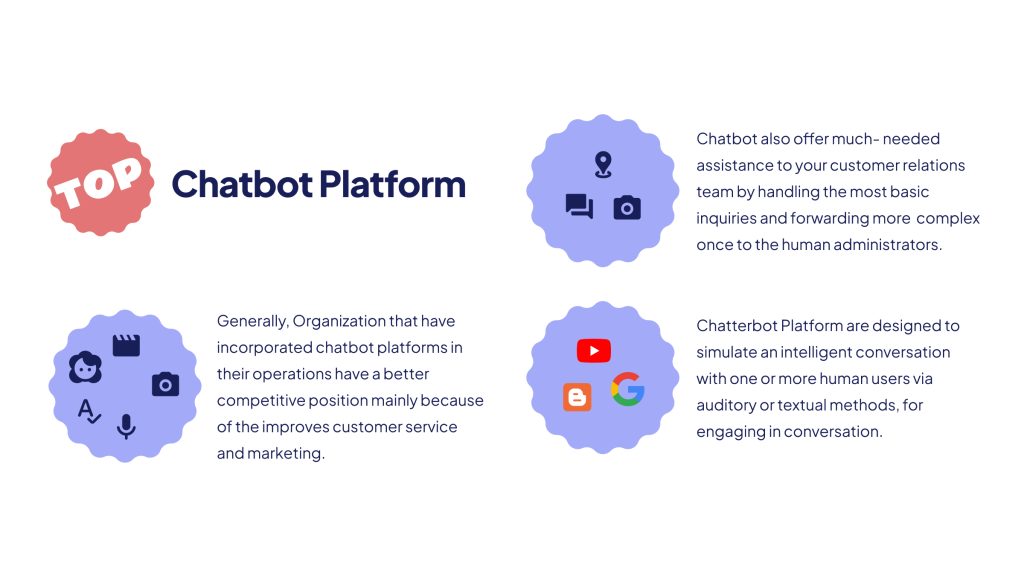
| Chatflow | Dialogflow X | RASA |
| Chatflow is a flexible chatbot platform noted for its user-friendly UI and powerful natural language processing (NLP) features. It integrates seamlessly with popular messaging applications and offers comprehensive customization possibilities, making it an excellent alternative for organizations looking for efficient and entertaining chatbot solutions. | Dialogflow X is a Google Dialogflow plugin that provides better AI-driven conversational experiences. It excels at language interpretation and context management, making it a popular choice among developers trying to build extremely sophisticated chatbots for a variety of applications. | RASA is an open-source chatbot development platform known for its adaptability and extensive customisation capabilities. It distinguishes itself by its machine learning capabilities and NLP integration, making it an excellent solution for enterprises who demand custom chatbots with extensive natural language processing skills. |
Steps To Build A Chatbot Using Natural Language Processing
Step 1: Determine the Goal of Your Chatbot
Determine your chatbot’s precise goals and intended purpose. Determine your target audience’s needs and expectations, and then identify the issues or tasks that your chatbot will handle.
Step 2: Selecting a Channel
Choose the platform or media via which your chatbot will be available, taking into account user preferences. Websites, smartphone applications, chat systems, and voice assistants are all options.
Step 3: Choosing a Technology Stack
Choose programming languages, chatbot frameworks, and natural language processing technologies based on your chatbot’s needs and capabilities.
Step 4: Create a Conversation Flow
Create a structured conversation design that details the user requests, chatbot replies, and overall engagement. Prepare for a variety of user situations.
Step 5: Educating The Bot
Teach your chatbot to successfully interpret and respond to user inputs. Typically, this entails training it on datasets and employing natural language processing techniques.
Step 6: Testing The Chatbot
Test your chatbot thoroughly for functionality, accuracy, and user experience. Identify and correct any problems or mistakes that occur during testing.
Step 7: Deployment and Upkeep of the Bot
Deploy your chatbot on the platform of your choice and keep it up to date. Update the chatbot on a regular basis to keep up with evolving consumer demands and technological advancements.
NLP & Chatbots
NLP and Chatbots: A Comprehensive Overview
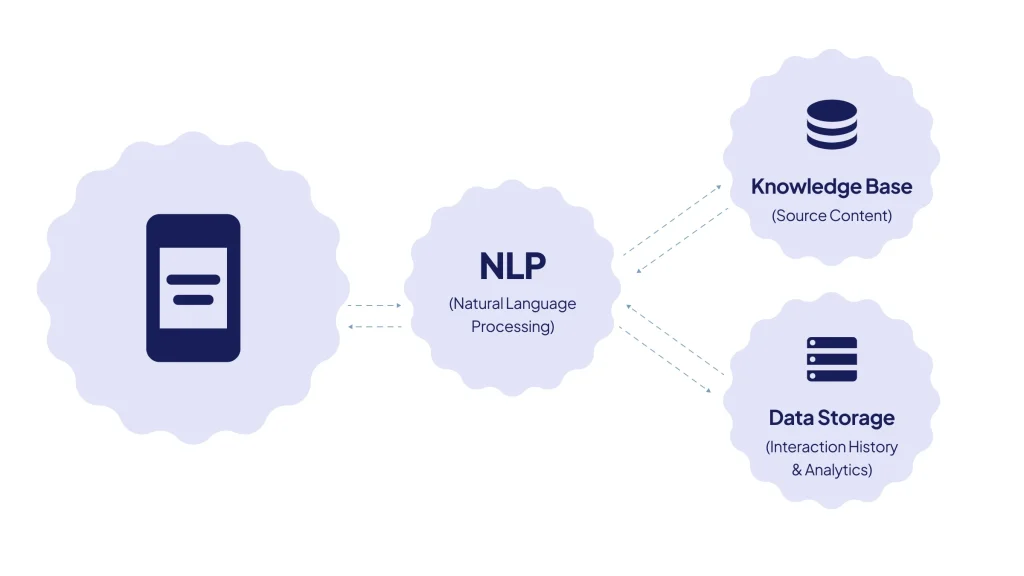
Chatbot NLP (Natural Language Processing) has heralded a new era of conversational AI, transforming the way we engage with technology. An NLP chatbot, also known as an NLU chatbot, is an intelligent software that processes and generates human-like text using natural language understanding (NLU) and generation (NLG).
Understanding NLP, NLU, and NLG:
To understand the essence of a chatbot NLP, we must first deconstruct the acronym.
- Natural Language Processing, or NLP, is the technology that allows chatbots to comprehend, interpret, and synthesize human language.
- Natural Language Understanding (NLU) is a subset of NLP that allows chatbots to understand user input.
- NLG, or Natural Language Generation, on the other hand, enables chatbots to answer to users in a human-like manner.
Evolution from Rule-based to NLP Chatbots:
The evolution of chatbot NLP has seen a considerable transition away from rule-based systems and toward increasingly complex, NLP-powered conversational bots. Rule-based chatbots were limited in their conversational skills since they followed a preset set of if-then rules. NLP chatbots, on the other hand, employ machine learning and NLU to interpret and respond to user inputs more flexibly and contextually.
Introduction to Generative AI Bots:
We are witnessing the growth of generative AI bots in the most recent chapter of Building a Chatbot Using NLP. These sophisticated chatbots, also known as generative NLP chatbots, are capable of producing non-predefined replies on the fly. They use huge language models like GPT-3 to generate human-like writing capable of engaging people in genuine and dynamic interactions.
Generative AI bots represent a significant advancement in NLP chatbot technology, providing a more fluid and adaptable user experience.
Building a Chatbot Without Coding
Building a Chatbot is no longer exclusive to developers. With build a Chatbot Without Coding, anyone can build and deploy chatbots to streamline various tasks and improve user interactions.
Here’s a detailed walkthrough of the process:
Step 1: Determine the Purpose of Your Chatbot
Before you begin designing chatbots, you must first define their purpose. Identify the difficulties or tasks that will be automated. This stage is all about determining the aims and goals of your chatbot.
Step 2: Determine Where Your Chatbot Will Appear
The next decision is where your chatbot will appear. Will it be housed on a website, a mobile app, or a messaging platform? Choosing the correct channel is critical to ensuring that your chatbot reaches its target audience.
Step 3: Choosing the Best Chatbot Platform
User-friendly platforms and tools are required for no-coding chatbot creation. Choose a chatbot platform that is compatible with your objectives and technological capabilities. These platforms frequently provide templates and drag-and-drop functionality to make the process more accessible to non-developers.
Step 4: Designing Chatbot Conversations
With a Chatbot Editor Most no-coding platforms have chatbot editors that allow you to create conversations without writing a single line of code. Create the chatbot’s interaction flow, including user questions and replies, using this editor.
Step 5: Evaluate and Train Your Chatbot
It is critical to test and enhance the performance of any emerging chatbot. Make sure your chatbot understands user input and answers correctly. For this aim, several no-coding systems feature built-in testing tools.
Step 6: Gather User Feedback
Feedback is essential for improving your chatbot. Encourage users to submit feedback and recommendations, and utilize this information to improve the performance and usability of your chatbot. This iterative procedure is critical to the success of chatbot development.
Step 7: Examine Chatbot Analytics for Potential Improvements
Analyze your chatbot’s performance to continuously improve it. Monitor user involvement, detect bottlenecks, and improve conversation flow. This data-driven approach is critical for creating chatbots that evolve and respond to customer requirements.
How Much Does It Cost To Develop A Chatbot?
The cost of building a chatbot varies greatly based on aspects such as complexity, features, and development methodology. Simple rule-based chatbots can cost as little as $1,000, but more powerful AI-driven chatbots can cost anywhere from $20,000 and $150,000 or more. Costs are also influenced by customization, integration, and continuing maintenance.

ChatBot Development Using Zethic Technologies
Zethic Technologies is a chatbot development company. Their services include bespoke chatbot development for a variety of applications. Zethic Technologies excels in the art of chatbot development. They craft customized chatbots to cater to a wide array of applications, ensuring your unique needs are met with precision and expertise. Zethic provides personalized chatbot solutions that match unique company goals, delivering a seamless and engaging user experience, with a heavy emphasis on AI and NLP. Their knowledge may assist firms in properly using the potential of chatbots.




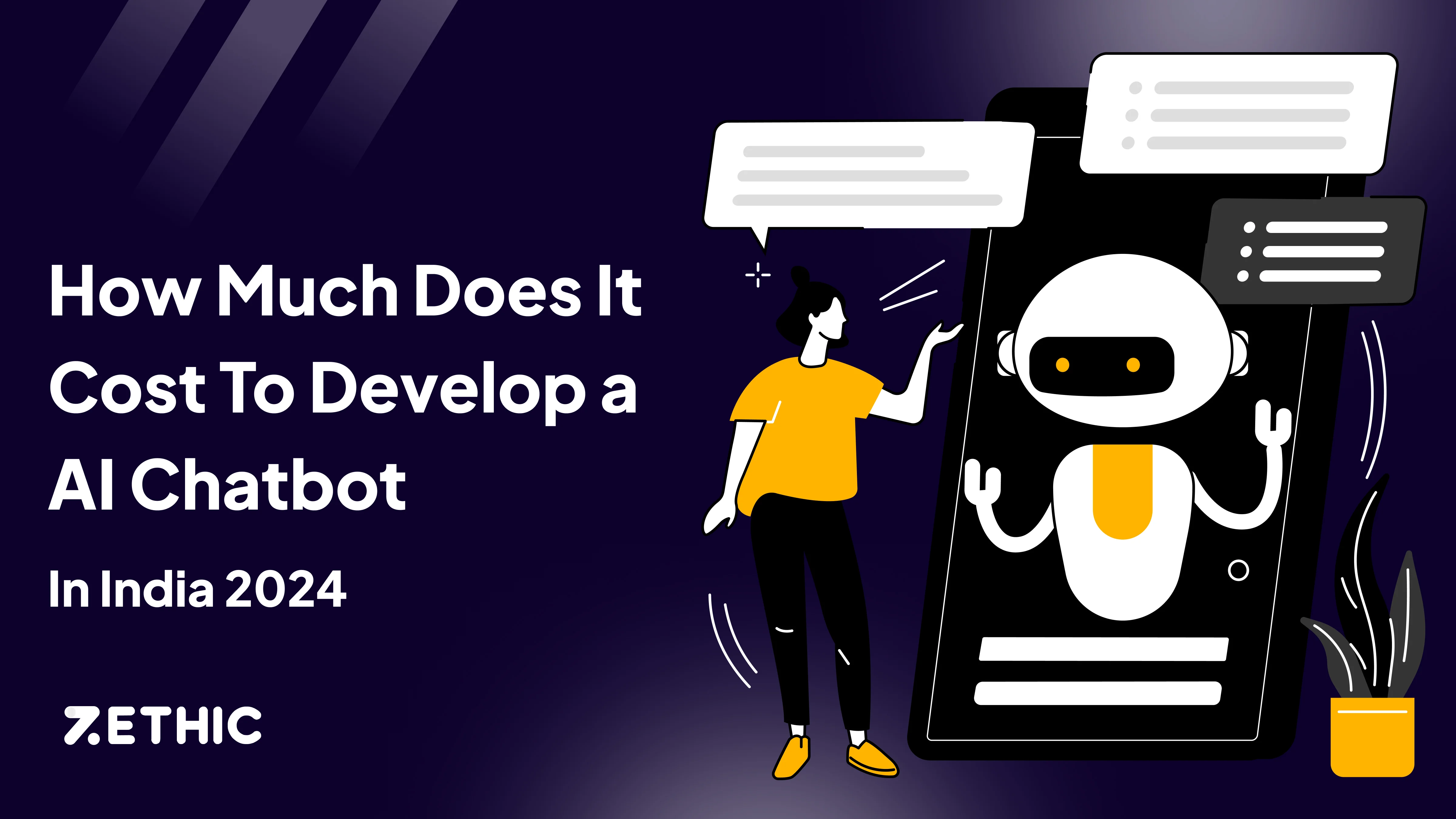
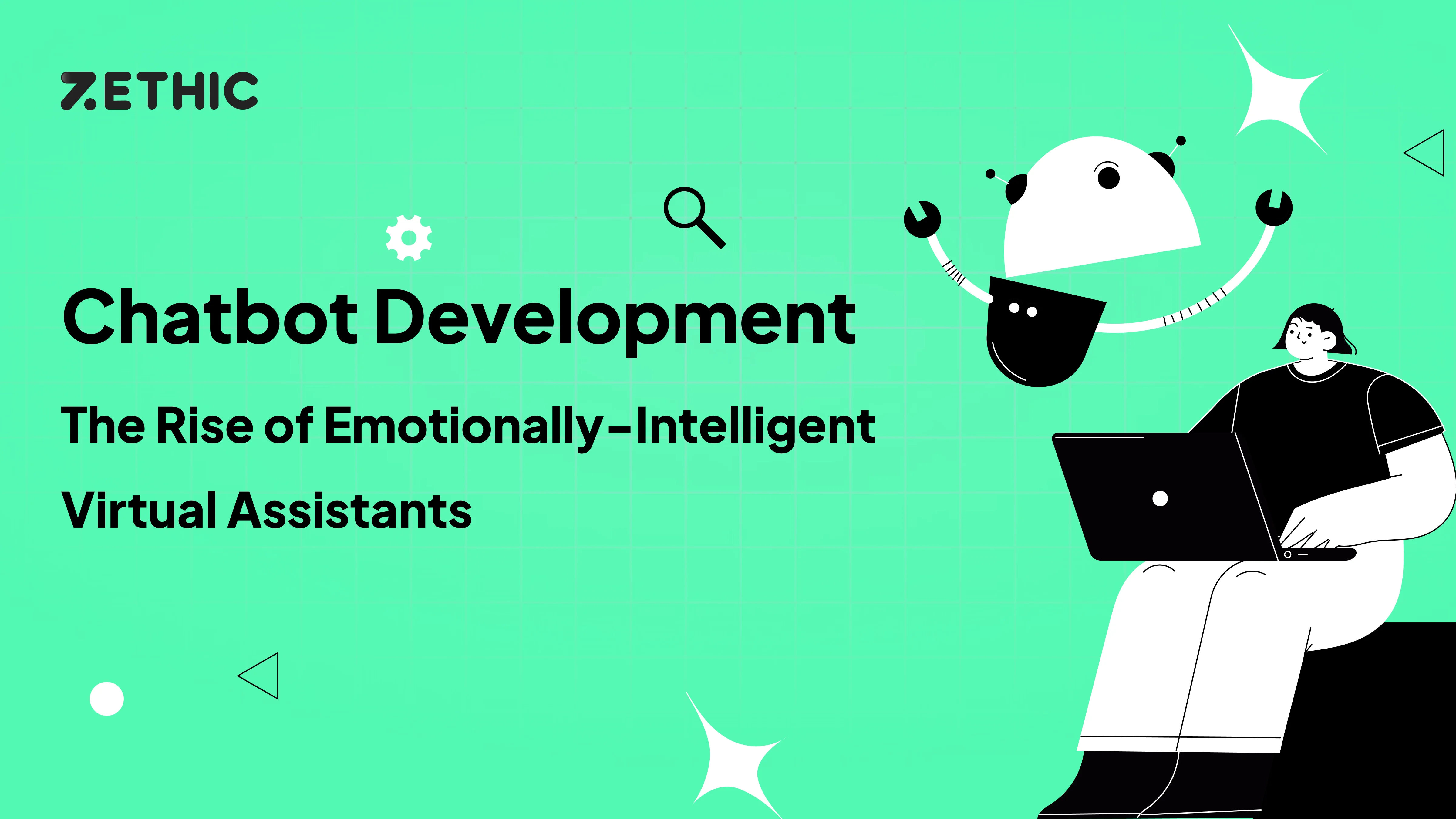
Thanks for sharing. I read many of your blog posts, cool, your blog is very good. binance referal code
Thanks for sharing. I read many of your blog posts, cool, your blog is very good.
I don’t think the title of your article matches the content lol. Just kidding, mainly because I had some doubts after reading the article.
Thanks for sharing. I read many of your blog posts, cool, your blog is very good.